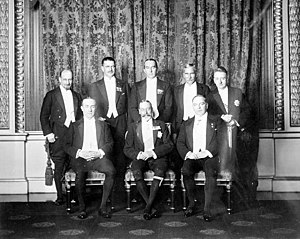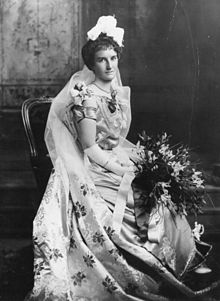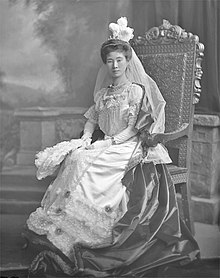Court uniform and dress in the United Kingdom
Specifically, court uniform was worn by those holding particular offices associated with the government, the Civil Service, the Royal Household, or similar national institutions.
For men, it comprised a matching tailcoat and waistcoat, breeches and stockings, lace cuffs and Cravat, cocked hat and a sword.
It consists of a tail-coat with matching waistcoat and breeches, lace cuffs and jabot, silk stockings, buckled shoes, cocked hat, white gloves and a sword.
In the eighteenth century, dress worn at court comprised gold and silver stuff, brocades, velvets and cloth coats.
[3] The cloth coat in 1898 had embroidery on collar, cuffs and pocket flaps, specified as similar to fifth-class civil uniform, 3⁄8 inch (0.95 cm).
[1] In 1908, the old-style court suit was of velvet, with a cut-back frock style, single-breasted with seven buttons and button-holes, but the coat was actually fastened edge-to-edge on the chest by a hook and eye.
A folding cocked hat in corded silk with a black loop and rosette and white gloves finished the dress, which was used for dinners, balls, and receptions.
In the twenty-first century old and new style velvet Court Dress has become the distinctive garb of High Sheriffs (see the external images in the links on the right).
It is a single-breasted cloth or velvet coat, of cut-away front style, with seven buttons although actually fastened edge-to-edge on the chest by a hook and eye arrangement.
The Clerks of both Houses wear short wig and gown over a legal cloth court suit, worn with trousers and white bow tie.
The Serjeants at Arms wear a cloth court suit of legal pattern with knee-breeches, white gloves and silver-hilted sword.
The Speaker's Secretary and his train-bearer wear a black cloth court suit of legal pattern, with lace frill and ruffles, steel buckles on breeches and shoes, cocked hat and sword.
For 'state or full dress dinners, and evening state parties', however, they were to wear a cloth court coat with knee-breeches and buckled shoes.
Waistcoat [if doublet is intended to be worn unbuttoned]- velvet, cloth, tartan; dress kilt; dress hose; plaid either shoulder or belted; shoulder brooch for plaid; dress sporran and strap or chain (sealskin, silver furnished top)- can be hair, fur, skin; Highland basket-hilt sword, black leather or metal mounted scabbard; sgian dubh (sock knife); dirk; kilt pin; jabot, lace (lace, silk, satin or lawn stock); cuffs, lace; Ghillie Brogue shoes (leather uppers, soles and tassels) or Dress shoes (with buckle); Highland Bonnet; belt and buckle (leather and lined); flashes; Highland pistols and powder horn may be worn; gloves are not worn.
[3] For women (as for men) court dress originally meant the best and most opulent style of clothing, as worn in fashionable and royal society.
A distinctive style can be seen in the dresses and accoutrements worn by courtly ladies in the Elizabethan period, and likewise in subsequent reigns.
Courtly garments, then, can be seen reflecting something of the contemporary fashions of high society, from the expansive skirts and crinolines of the 1850-60s, through the posterior bustles of the 1870s & 80s, right through to the straight gowns of the 1920s.
The full-dress uniform consists of a dark blue high-collar jacket with gold oak-leaf embroidery on the chest, cuffs and long tails; white breeches and stockings; and a cocked hat edged with ostrich feathers.
Levée dress is less ornate: the jacket is comparatively plain (with embroidery on the cuffs, collar and pockets only), and is worn with dark blue gold-striped trousers instead of breeches.
It had a dark blue single-breasted tail coat (or "coatee"), lined with black silk, the stand collar and gauntlet cuffs having scarlet velvet facings, gilt buttons, waistcoat, breeches or trousers.
White gloves were again worn, while patent leather military boots replaced the buckled shoes, and the sword accessories were similar to that on full dress, but with blue cloth frog.
For Privy Counsellors, on both levée and full dress coatees, the embroidery had a purl edging; the cocked hat was similar to that of the 1st class, but with additional hangers on the gold tassels.
[3] From the early 20th century the Privy Counsellors, 1st and 2nd classes' levée coatee embroidery was extended to include the centre back waist as well as the collar, cuffs and pocket flaps.
Within Her Majesty's Diplomatic Service ambassadors retain a simplified version[13] for wear on such occasions as the presentation of credentials and then only when accredited to certain countries.
The Governors of the few remaining colonial territories were notified in 2004 that the expense of providing uniforms would no longer be a recognised charge against the Foreign and Commonwealth Office.
Breeches, stockings and court shoes are now confined to coronations so trousers of the levee version are worn instead with full dress.
The Earl Marshal's officers (i.e. the Pursuivants, Heralds and Kings of Arms) wear similar coatees with varying degrees of embroidery.
Members of the diplomatic and consular services had the same embroidery on the collar and cuffs as on the full-dress blue coatee, but worked on (detachable) white cloth panels.
Members of the colonial service, on the other hand, wore dark blue gorget patches with gold braid, which varied according to rank (as did the number of buttons on the cuff).
Dressed to Rule: Royal and Court Costume from Louis XIV to Elizabeth II by Philip Mansel, London: Yale University Press, 2005, ISBN 978-0-300-10697-8.


















